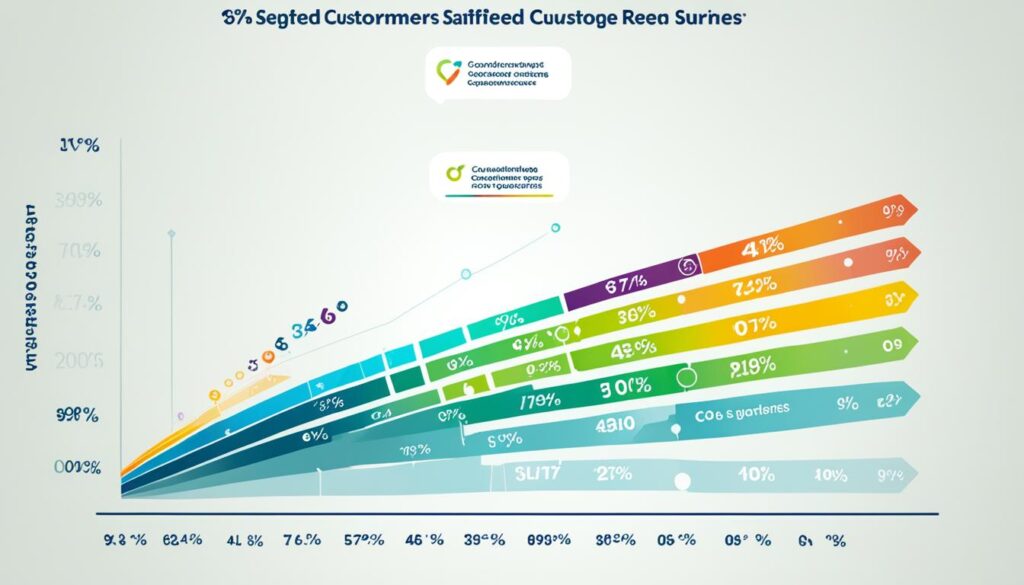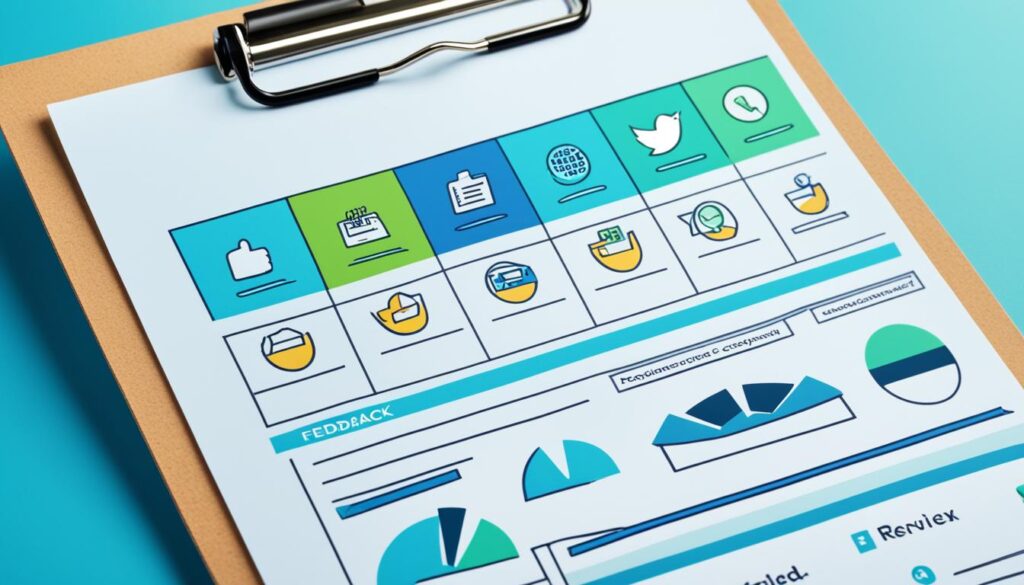Are you struggling to gather feedback and improve customer satisfaction? Only seven percent of customers respond to all the surveys they receive according to Khoros research. But fear not! Customer surveys are still a powerful tool for collecting valuable insights and enhancing customer happiness. Discover the essential steps to design an effective customer service survey and unlock the secrets to building strong customer relationships.
Creating a customer service survey is more than just asking a few questions. It requires careful planning, thoughtful design, and strategic implementation. But how can you ensure your survey hits the mark and provides meaningful feedback? Let’s explore the fascinating world of customer surveys and uncover the secrets to creating a survey that resonates with your customers.
The Importance of Customer Surveys
Customer surveys play a crucial role in assessing customer satisfaction, measuring engagement, conducting market research, and understanding customer expectations. These surveys provide valuable insights into customer motivations, preferences, and frustrations, helping businesses make informed decisions to improve their products, services, and overall customer experience. By listening to their customers’ voices, companies can enhance customer satisfaction, strengthen their brand image, and drive customer engagement.
Did you know that 80 percent of companies that see year-over-year growth actively use customer surveys to collect customer experience data? It’s no wonder why. Customer surveys allow businesses to stay connected with their audience, showing that their opinions matter and that their feedback is valued.
When customers feel listened to and appreciated, they are more likely to remain loyal and continue supporting a brand. With such a wealth of benefits, it’s no wonder that customer surveys have become a fundamental tool in the business world.

The Power of Customer Surveys
Customer surveys provide businesses with valuable insights that lead to numerous benefits:
- Data-driven decision-making: By collecting feedback through customer surveys, businesses can make data-driven decisions to better meet customer needs and expectations.
- Improving products and services: Surveys allow businesses to identify areas for improvement and make necessary adjustments to their products and services.
- Enhancing the customer experience: By understanding customer preferences and frustrations, companies can deliver better experiences, leading to increased customer satisfaction and loyalty.
- Strengthening brand image: When businesses actively seek feedback through surveys, customers perceive them as more customer-oriented and trustworthy, enhancing their brand image and reputation.
- Driving customer engagement: Surveys provide an opportunity for businesses to engage with their customers, foster a sense of community, and build long-lasting relationships.
| Benefits of Customer Surveys | Percentage of Businesses Using Customer Surveys |
|---|---|
| Enhanced customer satisfaction | 85% |
| Better understanding of customer needs | 79% |
| Improved product/service quality | 76% |
| Increased customer loyalty | 70% |
As customer satisfaction continues to play a critical role in business success, leveraging the power of customer surveys is a strategic move that can have a significant impact on a company’s growth and profitability.
Tips for Creating Effective Customer Surveys
To create effective customer surveys, follow these tips to ensure you gather valuable insights and maximize response rates:
- Define your survey goal: Clearly establish the objective of your customer survey. Are you seeking feedback on a specific product or service? Do you want to measure overall customer satisfaction? Identifying your survey goal will help guide the design and execution of your survey.
- Select the appropriate survey type: Different objectives require different survey types. Consider using customer satisfaction surveys, Net Promoter Score surveys, or churn surveys, depending on your specific goal. Each survey type provides unique insights into customer perceptions and behavior.
- Write clear and unbiased survey questions: Use language that is simple and easy to understand. Avoid leading or biased questions that may influence respondents’ answers. Clear and unbiased questions will provide more accurate and reliable data.
- Send surveys through relevant channels: Use channels that are most convenient and accessible to your target audience. Consider delivering surveys through in-product messages, your website, email campaigns, or text messages. By leveraging relevant channels, you increase the chances of reaching and engaging with your customers.
- Keep surveys short: Time is precious for your customers, so make sure your surveys are concise and focused. Long surveys can deter participation and result in incomplete responses. Inform survey respondents upfront about the estimated time required to complete the survey, ensuring transparency and managing expectations.
By following these tips, you can create customer surveys that effectively collect valuable insights and drive improvements in customer satisfaction.

Quote:
“Customer surveys are an essential tool for businesses to understand their customers better. By creating surveys with clear goals, suitable survey types, and concise questions, companies can collect accurate feedback and make informed decisions to improve customer satisfaction and loyalty.”
Best Practices for Creating Customer Surveys
When designing survey questions, strive for clarity and simplicity. Avoid using confusing terminology or making assumptions that could confuse respondents. Clear and straightforward questions will yield better results and provide valuable insights.
Limit the number of open-ended questions in your survey. While they can provide valuable qualitative data, too many open-ended questions can lead to repetitive or incomplete responses. Consider using a mix of closed-ended and open-ended questions to gather a balanced set of data.
Segment Customers Based on Their Survey Responses
Segmenting your customers based on their survey responses allows you to tailor your marketing campaigns to different customer groups. By understanding the unique needs, preferences, and pain points of each segment, you can improve customer satisfaction and deliver more personalized experiences. Use the collected data to create targeted messaging, promotions, and product recommendations that resonate with different customer segments.
Keep Survey Length Below Seven Minutes
Survey length is a crucial factor in ensuring high response rates. Keep your surveys concise and manageable by limiting the number of questions. Long surveys can be daunting and may lead to respondents dropping out. Aim to keep the survey completion time below seven minutes to maintain engagement and encourage participation.
Consider Offering Incentives
Incentives can be a powerful motivator for survey participation. Consider offering incentives such as:
- Monetary rewards
- Physical gifts
- Charitable donations
By rewarding participants for their time and effort, you can increase survey participation and generate more valuable data. Choose incentives that align with your target audience’s interests and preferences to maximize their effectiveness.

Setting Clear Objectives for Customer Surveys
Before conducting a customer survey, it’s important to establish clear objectives. One effective way to gather insights for shaping these objectives is by consulting employees who have direct interactions with customers. By tapping into their expertise and understanding of customer needs, you can gain valuable insights that will inform the survey design and the specific information you aim to collect.
To set clear objectives, start by determining the primary goal of your survey. What specific information do you want to gather? Are you seeking feedback on a particular product or service? Are you interested in understanding customer satisfaction levels or uncovering areas for improvement? Defining your main objective will help you focus on the core question that targets your primary goal.
In addition to the core question, consider including additional questions that can be periodically changed. This approach allows you to gather specific insights over time and adapt your survey to evolving business needs. For example, if sales are declining, your survey can help identify reasons for customer dissatisfaction and potential areas for improvement by incorporating targeted questions related to these issues.
By setting clear objectives and incorporating employee insights in the survey design process, you can create customer surveys that provide valuable and actionable information. These insights will enable you to make informed decisions, enhance customer satisfaction, and drive continuous improvement within your organization.
Types of Customer Satisfaction Surveys and Examples
Customer satisfaction surveys are a powerful tool for gaining insights into customer experiences and improving overall satisfaction. There are different types of surveys that businesses can utilize to measure specific aspects of customer satisfaction. The three main types of customer satisfaction surveys are:
- Net Promoter Score (NPS) Survey: The Net Promoter Score (NPS) survey measures customer loyalty and the likelihood of customers recommending a company to others. The survey asks customers to rate their likelihood of recommending the company on a scale of 0 to 10. Based on their responses, customers are classified into three categories: Promoters (scores 9-10), Passives (scores 7-8), and Detractors (scores 0-6). The NPS is calculated by subtracting the percentage of Detractors from the percentage of Promoters. The NPS provides valuable insights into customer loyalty and the potential for word-of-mouth recommendations.
- Customer Satisfaction Score (CSAT) Survey: The Customer Satisfaction Score (CSAT) survey measures overall customer satisfaction with a specific product or service. Customers are asked to rate their level of satisfaction on a scale of 1 to 5 or 1 to 10. The CSAT survey focuses on gathering feedback on specific interactions or experiences and provides a quantitative measure of satisfaction. CSAT surveys help businesses identify areas for improvement and monitor changes in customer satisfaction over time.
- Customer Effort Score (CES) Survey: The Customer Effort Score (CES) survey measures the ease of the customer’s experience when interacting with a product, service, or support team. Customers are asked to rate the level of effort required to complete a specific task or resolve an issue on a scale of 1 to 5 or 1 to 10. The CES survey aims to identify areas where customers may be facing challenges or frustrations, allowing businesses to streamline processes and reduce customer effort.
“Net Promoter Score, Customer Satisfaction Score, and Customer Effort Score are three essential metrics that businesses can use to understand customer satisfaction levels and make data-driven improvements.” – Mark Zuckerberg, CEO of Facebook
Example of Net Promoter Score (NPS) Survey:
| Question | Response Scale |
|---|---|
| How likely are you to recommend our company to a friend or colleague? | 0 – Not at all likely to 10 – Extremely likely |
Example of Customer Satisfaction Score (CSAT) Survey:
| Question | Response Scale |
|---|---|
| On a scale of 1-5, how satisfied are you with the product/service you received? | 1 – Very unsatisfied to 5 – Very satisfied |
Example of Customer Effort Score (CES) Survey:
| Question | Response Scale |
|---|---|
| On a scale of 1-10, how easy was it to resolve your issue? | 1 – Very difficult to 10 – Very easy |
Conclusion
Creating effective customer service surveys is crucial in understanding your customers, enhancing their satisfaction, and improving their overall experience. By implementing survey design best practices, you can gather valuable insights and drive business success.
To create impactful surveys, start by setting clear objectives. Identify what you want to achieve through the survey and tailor your questions accordingly. This will ensure that you collect valuable and relevant data.
Next, focus on writing clear and concise survey questions. Avoid complicated language or jargon that may confuse your respondents. Keep your questions straightforward and unbiased to gather accurate responses.
Utilize relevant channels to distribute your surveys. Whether it’s through in-product messaging, websites, emails, or text messages, choose the platforms that your customers are most likely to engage with. This will increase the response rate and provide you with a wide range of feedback.
Lastly, keep your surveys short and concise. Long surveys can lead to survey fatigue and decrease response rates. Inform your respondents about the estimated time it will take to complete the survey, ensuring that their time is valued and respected.
By consistently measuring customer satisfaction and acting on the feedback received, you can foster loyalty and drive revenue growth. Implementing these survey design best practices will allow you to create surveys that generate meaningful responses and help you provide exceptional customer experiences.
FAQ
How can I create a customer service survey?
To create a customer service survey, start by defining your survey goal and selecting the appropriate survey type. Write clear and unbiased survey questions, keeping them short and simple. Send surveys through relevant channels and consider offering incentives to increase participation.
Why are customer surveys important?
Customer surveys are important because they help assess customer satisfaction, measure engagement, perform market research, and gauge expectations. They provide valuable insights into customer motivations, preferences, and frustrations, helping improve products/services and strengthen the brand.
What are the tips for creating effective customer surveys?
The tips for creating effective customer surveys include setting clear survey goals, choosing the appropriate survey type, writing clear and concise survey questions, utilizing relevant channels, and keeping the surveys short to increase response rates.
What are the best practices for creating customer surveys?
The best practices for creating customer surveys include designing survey questions for clarity and simplicity, segmenting customers based on their survey responses, keeping the survey length below seven minutes, and offering incentives to increase participation.
How do I set clear objectives for customer surveys?
To set clear objectives for customer surveys, gather insights from employees who work directly with customers, determine the specific information you want to collect, and focus on a core question that targets the main objective. Include additional questions that can be changed periodically to gather specific insights.
What are the types of customer satisfaction surveys?
The types of customer satisfaction surveys include Net Promoter Score (NPS), Customer Satisfaction Score (CSAT), and Customer Effort Score (CES). NPS measures customer loyalty and referral potential, CSAT measures overall customer satisfaction, and CES gauges the ease of the customer’s experience.
Why is measuring customer satisfaction important?
Measuring customer satisfaction is important because it helps businesses understand their customers’ needs and preferences, identify areas for improvement, and enhance the overall customer experience. Regularly measuring customer satisfaction and acting on feedback received can lead to improved customer loyalty and increased revenue.
